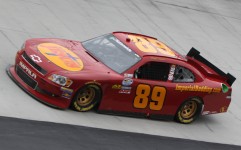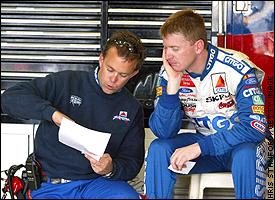If you thought six points isn’t a big deal, think again. Six points is the amount Nationwide Series driver Morgan Shepherd and his Faith Motorsports team trail owner Mark Smith by, the team that ranks 30th in Nationwide Owner Points. Not only do teams ranked 30th or higher get a guaranteed starting position for the next race, it also provides for bonus money.
[media-credit name=”Barry Albert” align=”alignright” width=”241″] [/media-credit]Shepherd finished 26th at Dover after completing 184 laps. Charles Lewandoski finished 42nd after completing just four laps, due to a reported ignition problem. But since Shepherd’s team ranks 31st in owner’s points, he only received a check for $12,700. Lewandoski received $11,950. Even though Shepherd finished 180 more laps, he only received $750 more, or $4.17 more per lap. That $750 doesn’t cover half a set of tires. Had Shepherd been in the top 30, he would have received money similar to Derrike Cope. Cope’s owner, Jay Robinson is 28th in owner points. Cope was befallen by an engine problem, but received $19,518. A safeguard, in effect for a bad race.
[/media-credit]Shepherd finished 26th at Dover after completing 184 laps. Charles Lewandoski finished 42nd after completing just four laps, due to a reported ignition problem. But since Shepherd’s team ranks 31st in owner’s points, he only received a check for $12,700. Lewandoski received $11,950. Even though Shepherd finished 180 more laps, he only received $750 more, or $4.17 more per lap. That $750 doesn’t cover half a set of tires. Had Shepherd been in the top 30, he would have received money similar to Derrike Cope. Cope’s owner, Jay Robinson is 28th in owner points. Cope was befallen by an engine problem, but received $19,518. A safeguard, in effect for a bad race.
Meanwhile, McDonald Motorsports ran afoul of such a system. Ranked 27th in owner’s standings; Donnie Neuenberger was flagged off the track after 70 laps for failing to maintain race pace after being involved in an accident not of his own making. He received a check for $18,743. The team’s second car, driven by Blake Koch was caught in the same accident and only won $11,892, due to being a part-time team. Even though it appears they had intentions of running a full race, they won the smallest piece of the pie.
In the confusing world of NASCAR, teams in the top 30 in owner’s standings receive a bonus payout for each race they enter. The posted purse was $1,014,243. Part of that money comes from the TV contracts and part of it comes from the track itself. NASCAR also offers others plans, such as the aforementioned “top 30” money. The purse is rounded out by contingency funds. For example, Coors Light posts a $3,300 for the driver who sits on the pole, so long as qualifying isn’t rained out. Featherlite offers a $2,400 bounty for the driver who improves their finishing position the most, compared to their finish in the previous race. Sunoco, Goodyear…it’s enough to make your head spin.
An e-mail to NASCAR seeking further clarification on the purse structure wasn’t immediately returned.
Some owners, such as Shepherd and Smith run a second or third car to help their underfunded operations. That car often parks in a short amount of time. That’s shouldn’t be seen as a problem—these teams aren’t trying to raid the purse—teams use that money to help fund their primary car, not to make money. Even that second car doesn’t help out a lot. “It costs $1200 to enter each race and a set of tires is $1900,” explained Shepherd. “Teams are in survival mode, but it’s all a chance. If there’s a problem…”
In comparison, teams have existed such as Phil Parson’s MSRP Motorsports. From 2008-2009, Parsons’ two cars completed exactly one race. That one finish came under clout; reportedly, another team was simply using the MSRP name. When Car and Driver’s Bob Zeller attempted to interview Parsons, he brushed off questions regarding MSRP.
The purse structure is a convoluted mess. NASCAR needs to do more to balance the money situation out, especially in the Nationwide Series. There’s a distinction between teams that actually show up to race, as opposed to those who cheat the system and take purse money from other hard working teams, especially with the Nationwide Car of Tomorrow going full time this season, a move that was supposed to be cost beneficial, according to Shepherd. “That was [NASCAR’s] thinking to get everything alike so we could use the same car everywhere. It came at a hard time with sponsorships and attendance being down. Teams are basically in survival mode,” he concluded.
Many fans watching the end of Sunday’s FedEx 400 noticed that during the last commercial break, a so-called “side-by-side” telecast aired. This wasn’t an accident, according to Dan Bell, Vice President, Communications for FOX Sports. “The idea [to go “side-by-side] re-surfaced earlier this week and after some discussion it was decided we would experiment with it if we could get enough advertisers to go along with it”, said Bell. “Three ardent NASCAR on FOX supporters, Sprint, Pizza Hut and Fed Ex all…agreed to work with us with the spots they planned to run in the race’s final break. At this point, the fan feedback from we’ve seen via social media has been very positive.”
FOX deserves kudos for listening to fans and delivering coverage that is enjoyed by many. This weekend’s All-Star Race airs on Speed, while the Coca-Cola 600 and the Kansas Speedway 400 wrap up FOX’s coverage for the year. Coverage then shifts to TNT for the next six races.
With what could be described as a frustrating season to date, Mark Martin finished strong for his first to five of the year. After a gutsy pit call by crew chief Lance McGrew to take the lead, Martin held pace for six laps before being overtaken by eventual winner Matt Kenseth. Surprisingly, the tires held and Martin was rewarded with his best finish since Martinsville last October. “Well kudos to Lance McGrew and everybody on this GoDaddy.com Chevrolet crew here. We ran good. But we were getting ready to finish 15th again and its been a shame because we have run that well a lot this year and finished 15th,” said Martin.
While Martin was celebrating his best run of the year, Jimmie Johnson was left wondering what could have been. Johnson dominated the first portion of the race, leading 207 laps in total. However, a four-tire call by crew chief Chad Knaus resulted in Johnson getting buried in traffic. Johnson could only muster a ninth. Many observers were surprised that four tires ended up being the wrong call, making it the second straight week a gutsy crew chief decision help decide the winner.
Johnson said that “I think the track conditions more affected the balance of the cars, especially as a run went on. There at the end, I really think that it was just dirty air and track position was the issue why the four-tire guys couldn’t get through. You are just going so fast around here, even though it is just a one-mile track, that clean air, just cleaner air towards the front makes a huge difference.”
Two other drivers had reason to be disappointed; AJ Allmendinger and Darlington winner Regan Smith. Allmendinger led at one point and was consistently in the top ten all race. Despite finishing, Allmendinger ended the race with a driver rating of 95.7; ninth best among all drivers. Smith spent the entire race on the lead lap until a track bar mount broke in the late stages. “What a difference a week makes,” said Smith. “The frustrating thing is that our Furniture Row Chevrolet was coming to life when the track bar mount broke during a caution (Lap 334). Our car really picked up steam during the second half of the green flag run before the caution came out. We were definitely in position to make a late-race charge and get a nice finish out of this race. I think we were running 16th when the mount broke. It hurts because we had a good car and wanted to continue the momentum from last week’s win in Darlington.”
Mark can be found on Twitter @SpdwyMediaModor.









